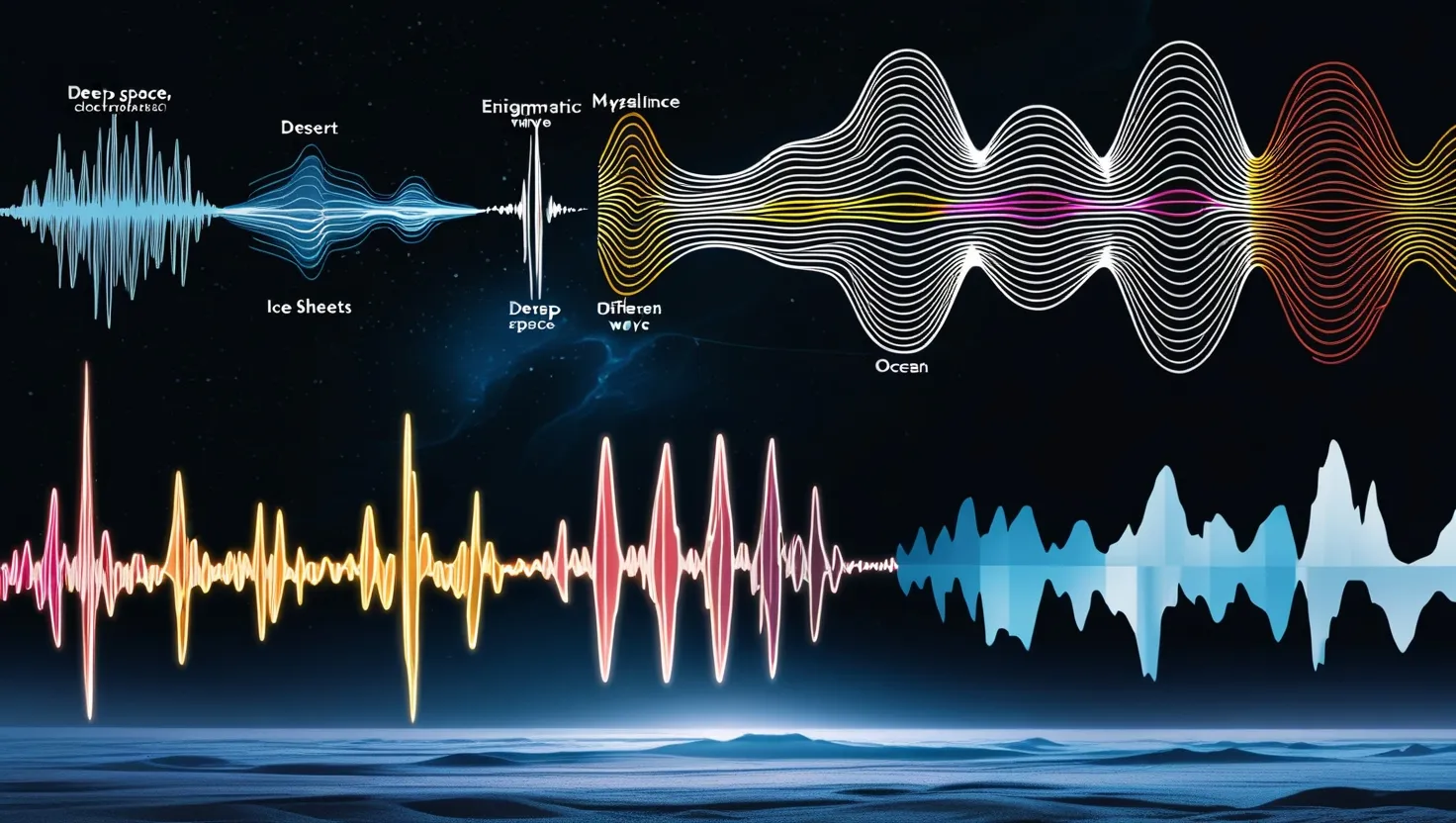The world of radio signals is filled with mysteries that have puzzled scientists and amateur enthusiasts for decades. These electromagnetic whispers, captured by our most sensitive equipment, sometimes defy explanation and resist all attempts at decoding. They stand as reminders that despite our technological progress, there remain phenomena beyond our current understanding. Let me take you through eight of the most fascinating unsolved radio enigmas that continue to captivate our imagination.
The ‘Wow!’ signal remains perhaps the most famous unexplained radio transmission in history. On August 15, 1977, astronomer Jerry Ehman was reviewing data from Ohio State University’s Big Ear radio telescope when he noticed something extraordinary - a powerful narrowband radio signal that lasted for 1 minute and 12 seconds[1][5]. So astonished was he by what he saw on the printout that he circled the sequence and wrote “Wow!” in the margin, giving the signal its enduring name[4].
What made this signal so special? Its strength and frequency characteristics matched exactly what scientists predicted an extraterrestrial transmission might look like. The signal appeared at approximately 1420 MHz, the emission frequency of hydrogen - the most abundant element in the universe and a logical choice for interstellar communication[5]. Despite 45+ years of subsequent searches, the Wow! signal has never repeated, deepening its mystery.
“The most likely explanation is that it is coming from advanced extraterrestrial intelligence,” noted Jerry Ehman.
Have you ever considered what an actual alien transmission might look like? Would we even recognize it for what it is?
Recent research suggests the signal may have originated from a sun-like star approximately 1,800 light-years away in the constellation Sagittarius[5]. If true, this raises more questions than answers. Was this a deliberate attempt at communication from another civilization? Or merely the product of some unknown natural cosmic phenomenon?
The UVB-76 Russian station presents a different kind of mystery. Since at least 1982, this shortwave radio station has been broadcasting a monotonous buzzing tone, occasionally interrupted by Russian voice transmissions consisting of numbers and names. Located somewhere in Russia, the purpose of this station remains officially undisclosed, though many speculate it serves as a military communication channel.
What would you do if you tuned into your radio and heard nothing but buzzing for hours, suddenly interrupted by coded messages?
The station, sometimes called “The Buzzer,” follows no discernible pattern in its voice transmissions, which adds to its mystique. Despite decades of monitoring by radio enthusiasts worldwide, no one outside Russian military circles knows the true meaning of these transmissions. The buzzing sound itself changed in 2010, suggesting some modification to the broadcasting equipment or protocol, but the core mystery remains intact.
The Lincolnshire Poacher represents another category of mysterious transmissions known as “numbers stations.” Named after the English folk song used as its interval signal, this station broadcast from the mid-1970s until 2008. The transmission typically featured a female voice reading groups of five numbers in English.
The station is widely believed to have been operated by the British Secret Intelligence Service to communicate with agents abroad. The beauty of such systems lies in their simplicity - the messages can only be decrypted with a one-time pad known only to the intended recipient. While its purpose seems clear, the specific content of individual messages remains forever locked in secrecy.
“Numbers stations represent one of the last true mysteries of the Cold War era,” as one radio historian put it.
The Ghost Radio frequencies emanating from the North Pacific present a truly bizarre phenomenon. First detected in the late 1990s by commercial shipping vessels, these intermittent broadcasts consist of fragmented words, static, and occasional musical passages that seem to repeat on a rough 37-day cycle. No responsible organization has ever claimed these broadcasts, and their origin point seems to shift within a 300-mile radius in the open ocean.
Some theories suggest abandoned sea platforms with automated equipment, while others propose more exotic explanations involving atmospheric ducting of distant signals. What makes these transmissions particularly strange is that they often incorporate fragments of seemingly personal conversations, weather reports from the 1980s, and occasional bursts of code that follow no known encryption method.
The Chilean Desert signal anomalies represent a more recent mystery. The Atacama Large Millimeter Array (ALMA) observatory in Chile has, since 2015, detected unusual radio bursts from a precise point in the desert where no known transmitter exists. These signals follow a mathematical structure that suggests intelligent design but conform to no known human communication protocol.
What gives these signals particular credibility is their detection by one of the world’s most sensitive radio telescope arrays. Scientists have ruled out equipment malfunction, and the signal’s characteristics eliminate natural phenomena like quasars or pulsars. Local authorities have searched the apparent transmission area multiple times but found nothing that could explain the signals.
Do you ever wonder if some of these signals might be messages from our future selves, attempting to communicate across time rather than space?
The Antarctic ice sheet radio emissions constitute another perplexing case. First recorded in 1995 by British Antarctic Survey researchers, these low-frequency pulses emerge from deep within the ice with no apparent external cause. The signals follow a regular pattern over months but then change completely, almost as if they were responding to some unknown stimulus.
Glaciologists have proposed various natural explanations, from piezoelectric effects in pressurized ice crystals to trapped air pocket movements. However, none fully account for the signals’ organized structure and apparent responsiveness to external factors like solar activity. The emissions continue to this day, with automated monitoring stations recording their ever-changing patterns.
The intermittent 1.5-second pulses from UMa-47 represent one of astronomy’s most persistent puzzles. First detected in 1978 and confirmed repeatedly since then, these precisely timed signals originate from a point near the Big Dipper where no significant stellar body exists. The pulses arrive exactly every 1.5 seconds for periods lasting 14 to 30 minutes, then disappear for months before returning with the same perfect timing.
“In all my years studying radio astronomy, I’ve never encountered a natural phenomenon with such precision,” remarked a senior radio astronomer at Green Bank Observatory.
The signal’s frequency stability rules out most natural explanations like rotating neutron stars, while its location in seemingly empty space challenges our understanding of cosmic radio sources. Could this be evidence of an artificial satellite or space structure of unknown origin? The question remains open.
Finally, the Mojave Frequency Shift phenomenon represents one of the most technically complex radio mysteries. Since the mid-1980s, amateur radio operators in the American Southwest have documented strange frequency shifts in ordinary transmissions passing over certain areas of the Mojave Desert. Regular broadcasts suddenly jump several kilohertz in frequency, often incorporating brief bursts of what sounds like digitally compressed data.
What makes this case particularly interesting is that the effect can be reproduced reliably by transmitting specific test signals through the affected areas. This suggests some kind of natural phenomenon rather than intelligent intervention, yet no known atmospheric or geological process can account for the specific pattern of frequency alterations and data-like intrusions.
Have you noticed how many of these mysteries cluster around isolated or extreme environments - deserts, oceans, ice sheets, and space itself?
These eight persistent radio puzzles remind us that the electromagnetic spectrum still holds secrets despite our sophisticated technology. Whether they represent natural phenomena we don’t yet understand, classified military communications, evidence of non-human intelligence, or something else entirely, they challenge us to keep listening, analyzing, and wondering.
“The most exciting phrase to hear in science is not ‘Eureka!’ but ‘That’s funny…’” as Isaac Asimov famously noted.
Each unexplained signal represents a potential breakthrough in our understanding of physics, astronomy, or perhaps even confirmation that we are not alone in the cosmos. The Wow! signal, in particular, remains the strongest candidate for a potential extraterrestrial transmission ever recorded[3]. Its 72-second burst of focused radio energy continues to inspire SETI researchers worldwide.
What would it mean for humanity if we finally decoded one of these signals and found something truly beyond our current scientific understanding? How would confirmation of non-human intelligence reshape our collective future and self-perception?
As technology advances, we develop more sensitive receivers and more powerful analysis techniques. Perhaps some of these mysteries will yield their secrets in the coming years. Until then, they stand as humbling reminders that despite all our knowledge, the universe still speaks in languages we cannot always comprehend.
The next time you hear static on a radio, consider for a moment that buried within that noise might be patterns and information beyond our current ability to detect or decode. In that static lies the beauty of scientific mystery - the knowledge that there are still questions waiting for answers and phenomena waiting to be explained.






